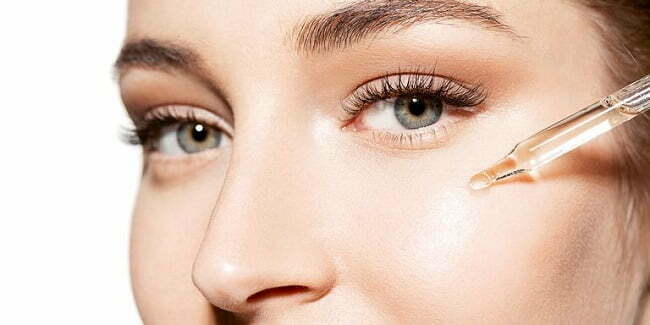The beginner’s guide to the ingredient you’re seeing everywhere.

Hyaluronic acid is the key to instantly plumping fine lines and making skin look glowy. It can be found in everything from serums to sheet masks and even injectables—but what exactly is it? We asked dermatologists to give us the 4-1-1 on hyaluronic acid, including the right way incorporate it into your skin care routine.
What is HA?
Hyaluronic acid (HA) is a sugar found naturally in our skin that holds water and helps keep it hydrated and plump. The HA within our bodies holds a thousand times its weight in water to not only retain all that moisture in our skin and joints, but also prevent all that moisture from evaporating into the air, according to Dr. Lily Talakoub, a dermatologist at the McLean Dermatology and Skincare Center.
Just like collagen and elastin, the amount of naturally-occurring hyaluronic acid in our bodies decreases as we get older. There are, however, ways to help stimulate production of HA in our bodies. “Diet affects the skin significantly,” says Dr. Howard D. Sobel, a dermatologist in New York City. “Eating fruits and veggies with lots of antioxidants protect the skin from inflammation in turn helps the skin retain it.”
HA is a Powerful Humectant
When used in skin care products like creams and serums, hyaluronic acid brings moisture to the surface of your skin. “Because of its ability to draw and hold water, it can be used as a humectant in your skin care regimen,” says Dr. Rachel Nazarian, a dermatologist at the Schweiger Dermatology Group in New York City. “It continually keeps skin moisturized throughout the day.”
Check the labels of your favorite skincare—chances are you’re already using it in some form or another. “As a topical [product], as long as it is in the right formulation, it will make the skin appear more dewy and younger because it improves skin elasticity,” says Dr. Kavita Mariwalla, a dermatologist in New York City and the founder of Mariwalla Dermatology. Hyaluronic acid is so powerful at pulling moisture to the surface of your skin, you likely don’t need to use it in more than one product in your routine.
Hyaluronic acid plays well with most other ingredients and can be paired with peels, retinols, vitamins, and other acids. Nazarian says the only exception would be acids with low pH levels, like glycolic acid, because it may degrade the HA and make it ineffective.
But picking the right hyaluronic acid product is tricky. The molecule is often times too large to effectively deliver hydration deep into skin layers. “[See] where the molecule is micronized or [if] the HA is in a vehicle that penetrates the skin in order to be effective where it needs to be,” she says. “Otherwise you are just putting it on top of the skin without it being helpful.”
Nazarian recommends products like the Proactiv Green Tea Moisturizer. “I love that it’s lightweight, and oil-free, so good for my acne-prone patients,” she says. “It also includes green tea, an antioxidant that works to improve skin aging, and hyaluronic acid to help maintain skins hydration.” Mariwalla is a fan of the SkinCeuticals Hyaluronic Acid Intensifier.
What are HA Injectables?
Injectables like JUVÉDERM and Restylane use a gel form of hyaluronic acid to add volume to the dermal layer of the skin. With a few pricks of a needle, the gel plumps sunken areas, smooths fine lines, and decreases shadows—then slowly dissolves over the course of one year. “In fillers, hyaluronic acid is bound in a gel carrier which holds it in place where it is injected,” says Mariwalla. “The hyaluronic acid creates volume because it draws in water to the area, creating a filling effect.”
Side effects are minimal: you may experience some swelling or bruising that can last for two or three days. The most important thing to remember when getting any kind of filler or injectable os to go to a trained and board-certified dermatologist or plastic surgeon. “Injectables do come with their own risk—it can be injected too superficially, or in rare cases, into a blood vessel,” says Nazarian.
Since hyaluronic acid is something our bodies already produce, it’s considered safe for use in all types of injectables. Take the liquid nose job, for example. Nazarian says dermatologists use filler to “even out bumps in the nose and improve the shape, or even to improve foot pain in patients who have lost the cushioning in their heels. It can be injected into the feet to improve the padding on the bone and decrease pain.”
Source: Harper’s Bazaar

